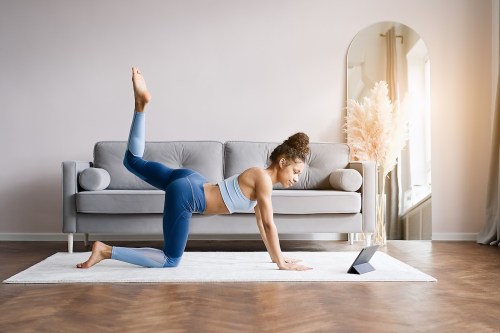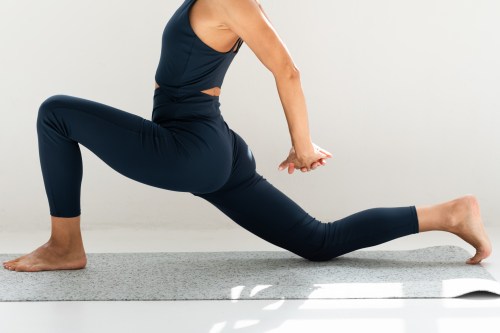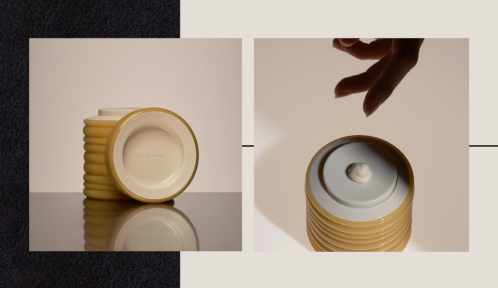Is Pilates hard? Well, Pilates workouts can be as hard or as easy as you want them to be. When you’re just getting started, there are plenty of basic mat exercises to strengthen your core and prepare you for what’s to come. And once you’ve reached that advanced stage, things get really fun.
Experts in This Article
instructor at East River Pilates in New York City
physiotherapist, master Pilates instructor, and founder of Go Chlo Pilates
founder and director of East River Pilates
If you want to level-up your at-home workouts, these Pilates exercises—some of the hardest Pilates moves around—are nothing short of a full-body challenge. Aside from putting your muscle strength to the test, they also test your balance and control. Without the proper skills, let’s just say there’s no way you’ll be doing swan dives or boomerangs anytime soon.
So, one question remains: How far down this list do you think you can go?
First, a basic refresher on Pilates
Developed by Joseph Pilates in the 1920s, Pilates is a form of exercise “designed to elongate, strengthen, and restore the body to balance,” according to the Pilates Foundation. It became popular with dancers at the time because it helped them improve their technique or recover from injury. Now, it’s a way for anyone to get a good workout in—there are almost 50,000 Pilates studios in the U.S.
You can choose between mat Pilates and reformer Pilates. Reformer Pilates is done on a reformer machine (typically found in a studio), which has a carriage that moves up and down a set of rails and features hand and foot straps. This offers more resistance than just your body weight. Mat Pilates, on the other hand, is done on, you guessed it, a mat. You use your body weight for resistance here.
What is Pilates good for? To put it simply, everything. Pilates benefits include improving your flexibility, posture, balance, coordination, strength, and overall body awareness, according to the Cleveland Clinic.
Yoga vs. Pilates
While both forms of movement are low-impact and focus on the mind-body connection, there are a few key differences between yoga and Pilates. Yoga may offer better stress reduction while Pilates may offer more strength benefits, Well+Good previously reported.
The hardest Pilates moves, ranked
1. Double leg stretch
This classic exercise is a great starting point, putting your core strength to the test as you extend both your arms and legs.
How to do it:
- 1.Lie on your back with your chin to your chest.
- 2.Extend your arms and legs, then hug your knees to your chest.
2. Diagonal reach
This exercise requires a lot of balance to do correctly, so prepare to get shaky.
How to do it:
- 1.Start in a tabletop position.
- 2.Reach your right and left leg out at a diagonal.
- 3.Hold, then bring your arm and leg out to the side, then back in.
- 4.Continue keeping your balance as you go back and forth.
- 5.Return to tabletop and repeat on the opposite side.
3. Swimming
The swimming exercise requires lower back, core, and glute strength to master.
How to do it:
- 1.Lie on your stomach with your arms extended.
- 2.Lift your arms and legs off your mat.
- 3.Swim your arms and legs as you inhale and exhale.
4. Roll-down
Instead of just lying down on your back, the roll-down works every muscle in your core as you slowly lower yourself.
How to do it:
- 1.Sit on your mat with your legs straight and arms extended in front of your body.
- 2.Scoop your tailbone and roll down, pulling your belly button into the spine.
- 3.Once you’ve rolled down as far as you can without touching the floor, pause then roll yourself back up.
- 4.Make it even harder by adding overhead reaches while you’re in your hold.
5. Hip twist
You’ll quickly discover how strong your core is with this exercise.
How to do it:
- 1.Start sitting on your mat. Extend your legs straight, and lean back, holding yourself up with your arms.
- 2.Your arms should be straight with your palms flat on the mat.
- 3.Circle your legs in one direction, then circle your legs in the opposite direction.
- 4.Continue alternating directions.
6. One-leg forward bends
Standing Pilates works your muscles in a new way, and this exercise is definitely a challenge.
How to do it:
- 1.Stand tall. Reach your right leg behind you with your toes touching the mat and your arms overhead.
- 2.Lower your upper body and right leg, staying in a straight line.
- 3.Return to your starting position, and repeat.
- 4.Repeat on the opposite side.
7. Pilates teaser
Doing a Pilates teaser correctly isn’t easy, but these instructions will help you master it at home.
How to do it:
- 1.Lie on your back with your legs together and arms overhead.
- 2.Engage your abs, lift your arms toward the ceiling, and peel up through the spine into a teaser position.
- 3.Find your balance as your legs hover in the air.
- 4.Scoop your tailbone under to lower back to the mat.
8. Jackknife
The jackknife is ridiculously challenging, whether you’re doing it on a reformer or your mat.
How to do it:
- 1.Lie on the mat with your arms by your sides.
- 2.Lift your legs, bringing them slightly behind you.
- 3.Lift your hips to bring your legs behind you.
- 4.Reach up, zipping up your legs.
- 5.Slowly lower your hips back down to your mat with control.
- 6.Lower your legs to the mat.
9. Swan dive
You’ll definitely want to take your time doing the preparations shown in this video before attempting a full swan dive.
How to do it:
- 1.Start on your stomach with your hands underneath your shoulders.
- 2.Press into the mat to lift your upper body.
- 3.Sweep your arms forward and kick your legs up, then continue to rock back and forth.
- 4.As the rocking becomes smaller, flatten out and lower your arms and legs to the mat.
10. Boomerang
The boomerang is considered one of the hardest Pilates exercises, as it requires every muscle in your body to do.
How to do it:
- 1.Sit tall on your mat, legs in front of you, ankles crossed, and hands by your sides.
- 2.Scoop your belly and round back, lowering yourself onto your mat one vertebra at a time.
- 3.Once you’re lying flat on the floor, immediately let your legs roll up and overhead. They should be parallel to the mat, and both of your arms should be forward on the mat.
- 4.Draw inward with a scooped belly and round back, and pull up into a V-sit.
- 5.Interlace your fingers behind you, arms outstretched, and chest lifted.
Safety tips to consider when doing advanced Pilates moves
For starters, it’s always best to get the green light from your doc before starting any new exercise routine—including Pilates. Once you’ve gotten the go-ahead, ensuring you’re doing each move with proper form is extremely important in order to prevent injury, according to Sun Rock Yoga. It can be helpful to do Pilates in a class with the oversight of an expert before tackling any Pilates moves—especially advanced ones—on your own.
On a related note, always listen to your body, per Sun Rock Yoga. If a move feels painful or simply not a good fit for your body, don’t continue with it or see if there’s a modification you can do.
Last, wearing the right clothing when doing Pilates is important. (And no, we don’t mean worrying about having the exact same sports bra as your favorite influencer.) Especially when it comes to reformer Pilates, clothing that’s baggy or has strings or zippers may snag on the reformer and lead to an injury, per Sun Rock Yoga. Even if you’re doing mat Pilates, these items may get in the way. If you have long hair, tying it back for the same reasons is recommended. Additionally, opt for grippy socks to avoid slipping during a move.
FAQ
1. Is Pilates hard for beginners?
Pilates is low-impact and a great option for people of all fitness levels and abilities. But like with any form of exercise, there may be a learning curve to Pilates if you’re new to it. If you’re a beginner, it may be helpful to take in-person classes so an instructor can help you nail the moves with proper form. And, most importantly, give yourself grace as you’re figuring things out. It’ll get easier over time.
2. What is the hardest part of Pilates?
While the answer may differ for everyone, there are a few common Pilates mistakes. Some of the toughest aspects of Pilates include resisting the urge to hold your breath during moves, knowing how to actively engage your muscles, and moving with your core.
Sign Up for Our Daily Newsletter
Get all the latest in wellness, trends, food, fitness, beauty, and more delivered right to your inbox.
Got it, you've been added to our email list.











